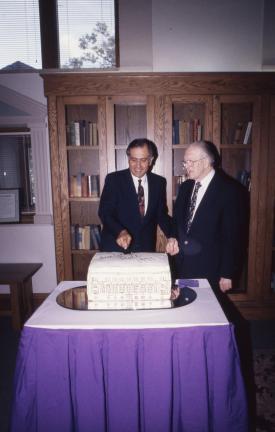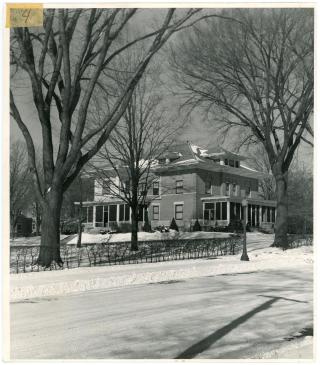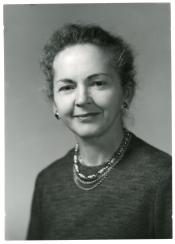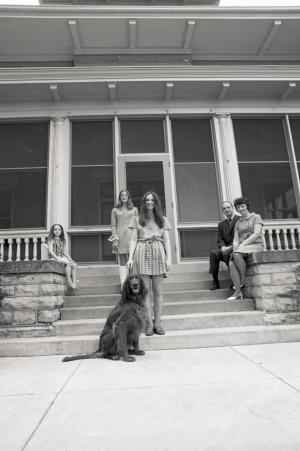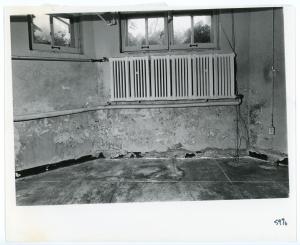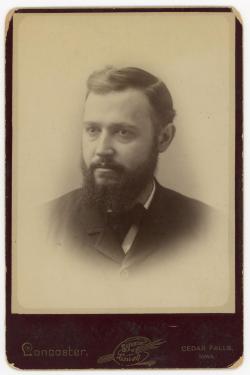 Prior to 1890, the chief executive officer of the Iowa State Normal School, now the University of Northern Iowa, lived in quarters in the classroom buildings. These quarters were inadequate for President and Mrs. Homer H. Seerley and their three young children, who arrived on campus in 1886.
Prior to 1890, the chief executive officer of the Iowa State Normal School, now the University of Northern Iowa, lived in quarters in the classroom buildings. These quarters were inadequate for President and Mrs. Homer H. Seerley and their three young children, who arrived on campus in 1886.
Consequently, in 1890, the state built a two-story brick house, known as the President's Cottage, for the family on the eastern edge of campus. This building is now the Honors Cottage.
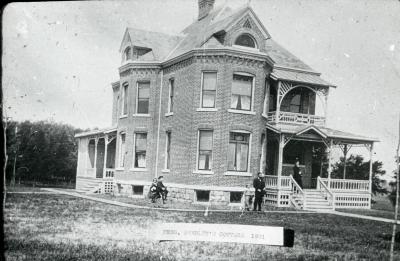 As the faculty and student enrollment grew, the President's Cottage proved too small for the entertainment and receptions that the President was expected to provide as part of his professional responsibility. So, in 1907, the Normal School Board of Trustees authorized the construction of a new President's House. The initial site was to be north of the President's Cottage, near the corner of what is now 23rd and College Streets. Superintendent of Buildings and Grounds James E. Robinson began to draw up plans for the house, which would be a "commodious and attractive structure." The Board hoped that work could begin yet in the fall of 1907 so that inside work could get under way during the winter.
As the faculty and student enrollment grew, the President's Cottage proved too small for the entertainment and receptions that the President was expected to provide as part of his professional responsibility. So, in 1907, the Normal School Board of Trustees authorized the construction of a new President's House. The initial site was to be north of the President's Cottage, near the corner of what is now 23rd and College Streets. Superintendent of Buildings and Grounds James E. Robinson began to draw up plans for the house, which would be a "commodious and attractive structure." The Board hoped that work could begin yet in the fall of 1907 so that inside work could get under way during the winter.
These ambitious construction plans were delayed. Not until January 28, 1908, did the Board approve Superintendent Robinson's plans and instruct him to prepare elevations. The Board directed that costs for the building not exceed $16,000. Funds for the work would come from millage tax revenues. The millage tax was a state real estate tax whose proceeds were used by the General Assembly for capital improvements at state institutions. Later, some critics would question the use of millage funds to construct a house, rather than classroom buildings. However, the General Assembly cleared the Normal School Board of Trustees of these charges.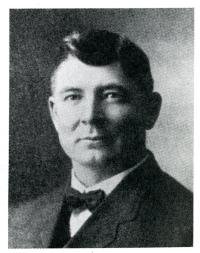
Officials hoped that construction could get under way during the summer of 1908, in coordination with the continuing construction of the new Library Building, now known as Seerley Hall. The site under consideration for the new house was still an area between the President's Cottage and the corner of 23rd and College Streets. But that would change. In May 1908, the student newspaper, the Normal Eyte, announced that the Board had rescinded its earlier plans for the site of the house. It would now be built south of the President's Cottage, near the intersection of 25th Street (now Seerley Boulevard) and College Street. This proved to be an excellent decision. The new location would be more peaceful and attractive than the initial site near the corner of 23rd and College Streets, where the College Hill business district had already begun to develop.
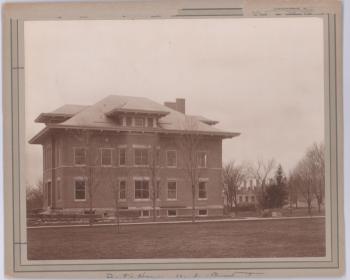 By September 1908, construction on the President's House was well under way. The foundation was complete and a shipment of bricks was expected any day. Students could watch the progress on their way to class from their College Hill boarding houses. They anticipated a beautiful house in keeping with the President's duties and responsibilities. By late September, masons were laying brick for the first floor. The Normal Eyte described some of the building's features "The roof will be moss green tile, the bricks will be light gray color, the verandas will be extensive and spacious and the whole appearance will be in keeping with the buildings of the institution." The last part of this statement is curious, for the new President's House would be distinctly different from campus buildings that existed then and that would be built for some time to come. To this day, the style and colors stand apart from other campus buildings, most of which are built along classic architectural lines with red brick, limestone trim, and reddish-orange tile roofs.
By September 1908, construction on the President's House was well under way. The foundation was complete and a shipment of bricks was expected any day. Students could watch the progress on their way to class from their College Hill boarding houses. They anticipated a beautiful house in keeping with the President's duties and responsibilities. By late September, masons were laying brick for the first floor. The Normal Eyte described some of the building's features "The roof will be moss green tile, the bricks will be light gray color, the verandas will be extensive and spacious and the whole appearance will be in keeping with the buildings of the institution." The last part of this statement is curious, for the new President's House would be distinctly different from campus buildings that existed then and that would be built for some time to come. To this day, the style and colors stand apart from other campus buildings, most of which are built along classic architectural lines with red brick, limestone trim, and reddish-orange tile roofs.
By September 29, 1909, the Normal Eyte reported that the house was just about done, and that President Seerley's family expected to move in within a week. The newspaper article also addressed the matter of what the building would be called. It noted that the school catalogue had previously called the residence of the President a "cottage". It went on to state that the new residence would be a
, , , house, not pretentious in its exterior, but still a house suited in roominess and arrangement to be the home of the president of the Iowa State Teachers College. It will be spacious enough to hold receptions for the faculty and senior students if the president so chooses.
So, at least unofficially, the new building would be called the President's House.
The President and his family moved into the new house on Monday, October 4, 1909. The Normal Eyte provided a detailed description of the home. The overall dimensions were 58 X 44 feet, with about 6000 square feet of usable space. The basement was concrete; in addition, the top level, or attic of the house could accommodate additional rooms. The basement included a laundry room, a drying room, a vegetable room, and a storeroom. A porch extended from the south door, across the east front, and around the north side. There was a smaller enclosed porch off the kitchen door. A covered balcony over the south porch could be used as an open air sleeping room. The floors and woodwork were oak and maple. There were two large parlors, a dining room, and a library on the main level. Some of the walls were covered with decorative paintings on canvas; the dining room paintings included "charming landscape views by a skilled Polish artist."
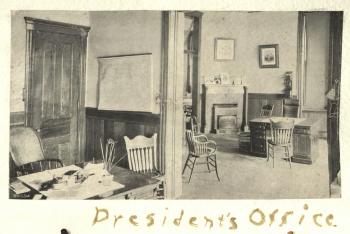 The President's study was on the second level. It would be equipped with a telephone connected to the switchboard in the President's Office, in the Old Administration Building.
The President's study was on the second level. It would be equipped with a telephone connected to the switchboard in the President's Office, in the Old Administration Building.
Thus, the President would be able to communicate quickly with faculty in their classrooms. Telephones would also be located in other parts of the house. The house was wired with a "tungsten electric lighting system". All utilities--heat, light, and telephone--would be brought to the house through a tunnel. The final cost of the building was $18,000, a bit higher than the original budget figure. Since the time of the completion of the building, all Presidents of UNI have been required to live in the campus house. It is used as living space for the president and his family, and for official open houses and receptions.
On February 7, 1910, the senior students were among the first to enjoy the hospitality at the President's House. President and Mrs. Seerley, along with several faculty members, were hosts at a reception for the students. In the parlors, the President received students, who then moved on to the dining room, where they were served "dainty refreshments". Not long afterward, at Commencement in June 1910, the returning alumni as well as senior students, enjoyed lunch on the lawn east of what is now Seerley Hall. Then they marched to the President's House, where President Seerley and Judge McDuffie, a member of the Board of Trustees, greeted them and gave them a brief tour of the new house.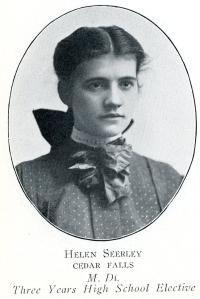
The house would continue to serve as the site for traditional events, such as senior receptions, for many years. But it was also the site for special events in the President's family. On November 23, 1911, Helen Clara Seerley, one of President and Mrs. Seerley's daughters, married Atherton Brockway Clark, an attorney from Cedar Rapids, at the house. President Seerley escorted his daughter into the parlors for the ceremony. The bride's sister, Esther, served as maid of honor. Ariel Parish played Lohengrin's Wedding March on the piano. After the ceremony, the guests enjoyed refreshments. The local newspaper, the Cedar Falls Record, notes that:
The spacious rooms were unusually attractive with their pink and white decorations and there was a quiet dignity and beautiful expression of home life in the entire ceremony.
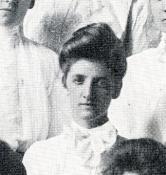 Several years later, on February 5, 1914, Esther Louise Seerley followed her sister's footsteps when she married Claude E. Culley, of Marshalltown, in the house. Helen Seerley Clark served as her sister's matron of honor. Dr. Clement C. Seerley, son of President and Mrs. Seerley, returned from his home in Montana to attend the wedding. The color scheme was again pink and white, with ferns, roses, and daffodils in an impressive display. After the ceremony, women from the V. O. V. sorority served about 125 guests in the dining room. Toward the close of the evening, a large group of college men serenaded the wedding party at the house.
Several years later, on February 5, 1914, Esther Louise Seerley followed her sister's footsteps when she married Claude E. Culley, of Marshalltown, in the house. Helen Seerley Clark served as her sister's matron of honor. Dr. Clement C. Seerley, son of President and Mrs. Seerley, returned from his home in Montana to attend the wedding. The color scheme was again pink and white, with ferns, roses, and daffodils in an impressive display. After the ceremony, women from the V. O. V. sorority served about 125 guests in the dining room. Toward the close of the evening, a large group of college men serenaded the wedding party at the house.
In the years following their daughters' marriages, the Seerley home was the scene of many visits from grandchildren. Homer Culley, born in the President's House in 1915 and named for his grandfather, must have been a special favorite. In later years Mr. Culley recalled enjoying visits to his grandparents' house and running around campus.
After President Seerley retired in 1928, President Orval Ray Latham, his wife Helen, and their two children moved in. Improvements to the President's House during the Latham years are not especially well-documented. During those difficult Depression years, other campus projects probably took priority for the limited funds that were available. However, in the summer of 1932, the lawn was re-seeded and a new railing was installed around the parking area. Following President Latham's untimely death in 1940, President Malcolm Poyer Price, his wife Mary, and their two children became the next residents. The College Eye reported that they encountered an invasion of bats in the summer of 1943, but replacing a fireplace chimney screen cured that problem.
President Price resigned the presidency in 1950 and joined the Education faculty. James W. Maucker then became President. He moved into the house with his wife Helga and their three young children, Jim, Ann, and Robert. In 1951, the three story brick structure was redecorated. The dark oak paneling was painted a lighter color. The dark carpeting was replaced with a gray-green carpet. There were new drapes and new upholstery. In 1960 the house received a new roof.
Several years later, in 1962, Mrs. Maucker described the house and the way that her family used it to College Eye reporter Mary Furlong. At the time of the interview, the house had twenty-one rooms, with a porch on the north, east, and south, and a covered balcony porch on the second level of the south side. The high ceilings and some of the "old colored wallpaper" had survived the 1951 renovation. The overall color scheme was green and yellow. The basement included a laundry room, an ironing room, a tool room, and a recreation room, where the Mauckers kept their television set and a ping-pong table. The first floor contained parlors, a reception area, the kitchen, the dining room, and a breakfast room. Mrs. Maucker said that the family usually ate in the breakfast room rather than in the more formal dining room. She prepared the family meals in the kitchen, with its complement of appliances--stove, refrigerator-freezer, and dishwasher--and generous counter space.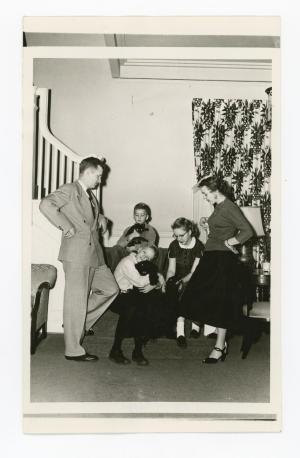
The Maucker family enjoyed music. They had a "hi-fi" system and a large collection of records. Bob and Ann Maucker sometimes played piano and cello in the southeast parlor. This level also contained a library that sometimes functioned as a cozy gathering place for small groups. The house included mementos of President Maucker's travel and professional service. But it also included small trees. Mrs. Maucker said, "Having trees in our home is one of my few hobbies. After smelling the beautiful fragrance of lemon blossoms in the flowering season in California, I decided to grow trees. The lemon tree is in the Greenhouse right now." The upstairs included five bedrooms, with the Maucker family using four of them and the remaining room designated for guests. During the Mauckers' residence in the house, Eleanor Roosevelt stayed in the guest bedroom when she was on campus for a speech in 1955. The Mauckers did not use the rooms on the top, or attic, level.
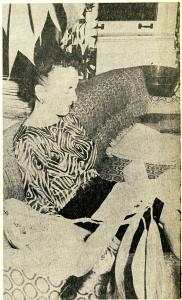 Again, in 1966, Mrs. Maucker described the house. It was much the same as in 1962, though one of the bedrooms had been converted to a study. She was also anticipating another round of carpet and upholstery replacement, probably the result of the normal wear and tear of raising a family in the house. Mrs. Maucker provided several details about the furnishings of the house. There was an ornate grandfather clock, a grand piano, a portrait of President Maucker by Coach Art Dickinson, and a stereo system. Mrs. Maucker also maintained maps in the dining room that showed her children's travels around the world. She said that she enjoyed the house, especially the large porches. She did note, though, that it took a lot of steps to get from one place to another. The Mauckers entertained new faculty, graduating students, and townspeople regularly in the house. But Mrs. Maucker regretted that they could not entertain even more students: "I wish we could entertain more students here--it is a matter of time, space, and energy."
Again, in 1966, Mrs. Maucker described the house. It was much the same as in 1962, though one of the bedrooms had been converted to a study. She was also anticipating another round of carpet and upholstery replacement, probably the result of the normal wear and tear of raising a family in the house. Mrs. Maucker provided several details about the furnishings of the house. There was an ornate grandfather clock, a grand piano, a portrait of President Maucker by Coach Art Dickinson, and a stereo system. Mrs. Maucker also maintained maps in the dining room that showed her children's travels around the world. She said that she enjoyed the house, especially the large porches. She did note, though, that it took a lot of steps to get from one place to another. The Mauckers entertained new faculty, graduating students, and townspeople regularly in the house. But Mrs. Maucker regretted that they could not entertain even more students: "I wish we could entertain more students here--it is a matter of time, space, and energy."
President Maucker resigned in 1970. But before he left campus he recommended certain improvements to prepare the house for incoming President John J. Kamerick, his wife Elaine, and their family. President Maucker recommended the installation of air conditioning, upgrades in plumbing and heating, and exterior work. In June 1970, the Board of Regents approved $54,000 for the work. This project met with some opposition from students who questioned the need to improve the President's House while the university was raising rent for student housing at the same time.
Changes in presidential administration seem to have been appropriate times to make improvements in the President's House. Beginning in the summer of 1983, following President Kamerick's resignation, the building underwent major renovation, restoration, and maintenance in preparation for the new President, Constantine Curris, his wife Jo, and their family.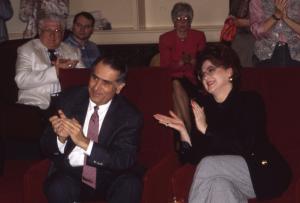
This project was extensive and substantial with costs totaling over $200,000. The work included a new heating, cooling, and ventilation system. This was more than a decade after President Maucker recommended the installation of central air conditioning in the President's House.
Other work included an electrical service upgrade, repairs to a basement wall, a new foundation under the back porch, new carpeting on the main level, refinishing the woodwork, remodeling the kitchen, landscaping, and installing a privacy fence around the backyard.
The size of this project, as well as President and Mrs. Curris personally, received a certain amount of criticism from a few students and faculty. However, university administrators pointed out that the project had been approved by President Kamerick's cabinet before the Currises arrived. They also noted that the kitchen had not been remodeled since the 1940s, the carpet was almost thirty years old, and that portions of the house were becoming structurally unsound. Installing a new boiler in the house made sense, because the old steam tunnel ran from the Old Administration Building. With that building scheduled for demolition, the line would have needed to be re-routed at considerable expense. They pointed out that it was easier to catch up on postponed maintenance while the house was unoccupied. The work stretched on into 1984.
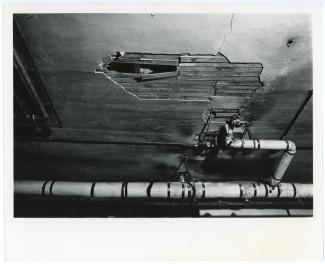
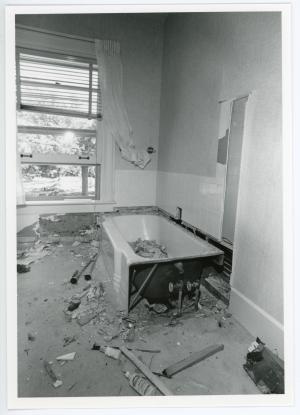 Several years later, in 1986, a problem arose. The remodeling of the kitchen had apparently not been well planned. Some of the equipment, particularly the exhaust system, was not performing well. The system was either inadequate in power, or had been installed too far from the stove to do its job. In addition, the stove, which included a double oven and double cooktop, did not function well. That appliance was replaced with separate oven and cooktop units. Several cabinets were shifted and an island was removed to accommodate the changes. The budget for the project was about $6000.
Several years later, in 1986, a problem arose. The remodeling of the kitchen had apparently not been well planned. Some of the equipment, particularly the exhaust system, was not performing well. The system was either inadequate in power, or had been installed too far from the stove to do its job. In addition, the stove, which included a double oven and double cooktop, did not function well. That appliance was replaced with separate oven and cooktop units. Several cabinets were shifted and an island was removed to accommodate the changes. The budget for the project was about $6000.
President Curris resigned in 1995, and President Robert Koob and his wife Yvonne moved into the President's House. During the Koob's residence in the house, there were substantial improvements to the exterior. Probably the most noticeable change was in the driveway to the house. Formerly, the driveway leading back to the garage had opened onto College Street. That portion of the driveway was closed, regarded, and sodded so that the only vehicle access to the garage was from the west, onto Wisconsin Street. In addition, there were substantial improvements to the drainage and landscaping around the house. A black metal fence was erected along the College Street side of the house. And attractive perennial beds, including hostas, were established or enhanced.
When President Koob resigned in 2006, there was another opportunity to improve and repair the house in anticipation of the arrival of President Benjamin Allen and his wife Pat. A new roof was put on in the summer of 2006 and there were extensive repairs to the porches.
Compiled by Library Assistant Susan Witthoft and Student Assistant Jennifer Grant; edited by University Archivist Gerald L. Peterson; Special Collections and University Archives; July 1996; substantially revised by Gerald L. Peterson with scanning by Library Assistant David Glime, July-August 2006; last updated November 16, 2011; photos and captions updated by Graduate Assistant Eliza Mussmann March 23, 2023.

